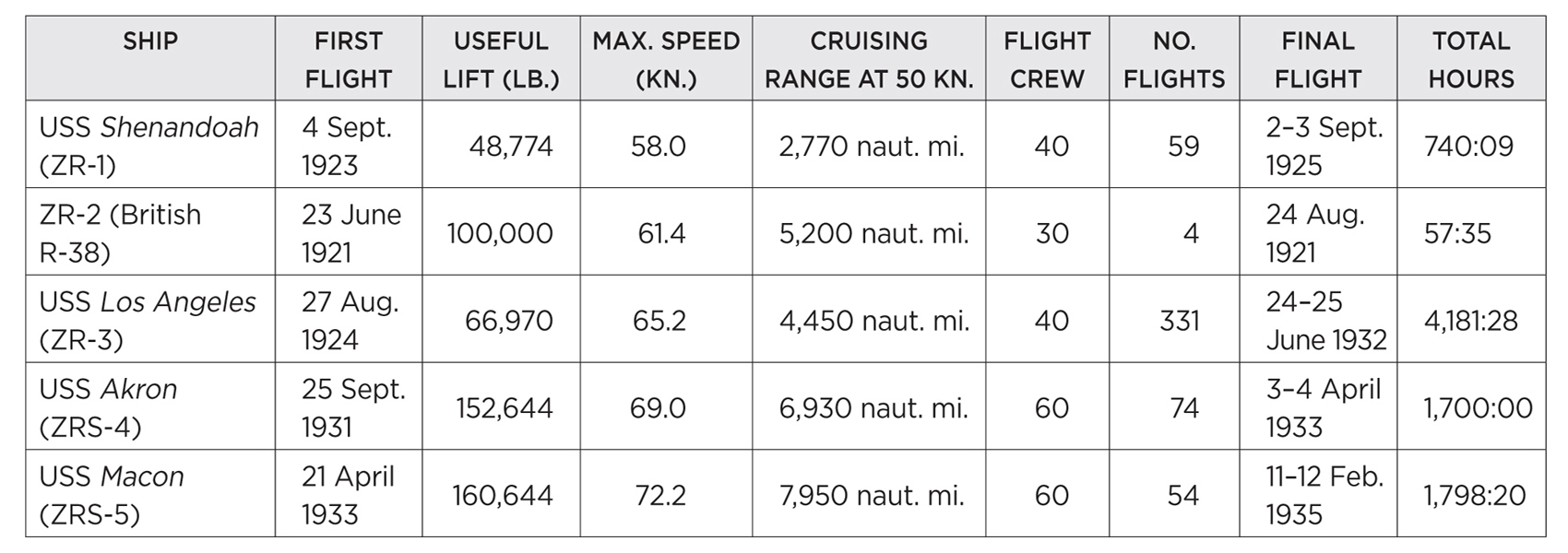Performance and Other Data for U.S. Navy Airships (1915–61)
Navy Nonrigids, 1915–22
U.S. Navy lighter-than-air began in 1915 with the DN-1 (Dirigible, Nonrigid, No. 1). On 20 April, the Navy contracted for one blimp with the Connecticut Aircraft Company. Completed two years later, the ship was delivered to NAS Pensacola, Florida. Badly overweight and a disappointment, DN-1 made a few short flights, after which it was deflated in its hangar and eventually broken up. But the pressures of war greatly accelerated Navy interest in the nonrigid airship or blimp. Procurement of free and kite balloons for training also dates from this period.

* Various test engines ranging from 100 to 150 horsepower.
Hydrogen inflated, the improved C-type blimp had a gross lift of about 11,650 pounds, with a fixed weight of 7,600 pounds for the envelope or bag, car, motors, and rigging. But the B-ships were the backbone of the wartime LTA program. It is of interest to note the distribution of C-ship “disposable weights” for an average antisubmarine patrol or convoy escort during the Great War:
|
Pounds |
Fuel (gasoline and oil) |
1,500 |
Crew (four) |
720 |
Armament (one Lewis gun, four 270 pounders) |
1,200 |
Radio |
250 |
Ballast (water and sand) |
200 |
Equipment (sea anchor, parachutes, etc.) |
180 |
Total |
4,050 |
Navy Rigid Airships (ZRs)
The U.S. Navy’s program for large naval airships dates from July 1919, when Congress authorized a naval air station to erect and operate rigid airships, and to procure two big ships of the rigid type: ZR-1 and ZR-2. The Navy would build only three rigid airships and operate only four total. All flight operations ended with the loss of Macon on 12 February 1935. Delivered to Lakehurst from Germany in October 1924, Los Angeles (ZR-3) proved indispensable for training and as platform for development projects. Decommissioned on 30 June 1932, L.A. never flew again. Reconditioned for “experimental development” in a non-flight status, she was exploited for mooring-out tests and finally dismantled during October–December 1939.

Navy Nonrigids, 1922–38
During its tenure, the rigid airship, or ZR, absorbed the resources and energy of the lighter-than-air program and overshadowed the nonrigid type, or blimp. Used for training and development, the naval nonrigid suffered from miserly appropriations until the eve of the Second World War. As a consequence, NAS Lakehurst in this interval was obliged to operate an odd assortment of increasingly obsolete aircraft.

a Deflated and taken out of service late 1924.
b Former Goodyear Defender; specifications are after modification.
c Former Goodyear advertising ship; ordered on same contract as K-2.
Navy Nonrigids, 1941–45
The urgencies imposed by the war at sea accelerated nonrigid research and development and the number of operational aircraft. As the Second World War progressed, new equipment and sensors were adapted to the platform, so envelope volume of the workhorse K-type airship was increased to accommodate the additional weight and improve overall performance. Airship experimentation intensified, with many technical innovations achieved.

a Undetermined number were enlarged to 456,000 cu. ft. starting in 1944.
Navy Nonrigids, Postwar Period
The Second World War proved to be the high-water mark of the lighter-than-air program. The standard K-type was modified twice, producing the ZSG-2 and ZSG-3, and a final configuration, the ZSG-4. The Korean War revived concern for antisubmarine warfare (ASW)—hence the ZPG-2 platform. Also, the Cold War threat of surprise attack on the continental United States incited design and introduction of the airborne early warning (AEW) airship: the ZPG-2W and ZPG-3W. Progressive force reductions were initiated in 1957. The fleet-airship program was terminated officially on 31 October 1961. The final flight of a U.S. Navy airship at NAS Lakehurst was logged on 31 August 1962.
